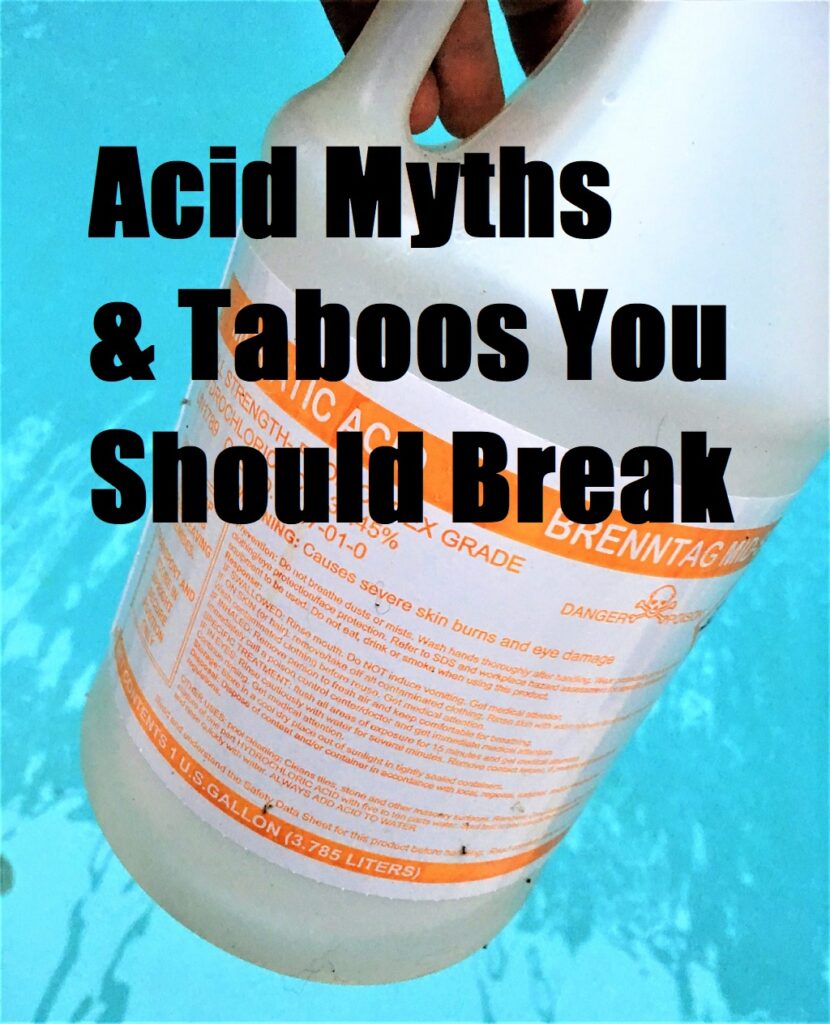[responsivevoice_button voice=”UK English Male” buttontext=”Listen to Post”]
Can the Acid Slug Lower Total Alkalinity Without Affecting pH?
The ability to control whether you lower Total Alkalinity or pH by the method in which a dose of acid is added to a swimming pool would certainly be of great value to the Pool Operators.
“To lower Total Alkalinity drastically with only a slight effect on pH, simply take your dose of acid and pour it slowly into one spot in the deep end of the pool. You’ll actually see the bubbles forming around where the “slug” is added – that is, the bicarb burning off and bubbling up. If you wish to lower the pH without also reducing the Total Alkalinity, simply pour the dose of muriatic acid about the pool.“
This would all be wonderful if it was only accurate. Still, just like the mythological “Chlorine Lock,” folkloric tales within the swimming pool industry do persist. But, Lowering Total Alkalinity Without Affecting pH?
When hydrochloric acid (HCl) is added to water, the molecules disassociate into both hydrogen ions (H+) and chloride ions (Cl–). This happens, no matter how it is added. To keep it simple, when you increase the number of hydrogen ions in a solution, the water becomes increasingly acidic. Remember, pH stands for Potenz Hydrogen, which can be interpreted from the original German to “Hydrogen Concentration.” So, if adding acid to water increases the hydrogen ion concentration no matter how you add it and pH (Potenz Hydrogen) is the “Hydrogen Concentration”… Hmmm?
All prepared to conduct my own experiments for this article so that I could offer definitive proof to those firm believers of Acid Slugology, I stumbled across some research that had been conducted by the folks (Kim Skinner, Que Hales, and Doug Latta) at onBalance. Their study, Laying to Rest the Acid Column Myth, involved an experiment which depicts precisely what happens, where the acid goes, and the potential danger in the “Slug” and/or “column.” Instead of replicating the experiments, I reached out to my friend and associate Que Hales, who gave his blessing in our sharing their results.
To conduct the research, Que and the gang added phenol red powder to the acid to give it a bit of color (acid is clear, you wouldn’t have seen it otherwise). Acid is heavier than water, so it only makes sense that it would sink to the bottom of the pool after you add it. Then, with an underwater camera, they snapped shots in a play-by-play account of what actually occurs.
What was observed was a dose of acid sitting at the floor of the pool for hours…? Consider the potential damage that could occur with a “slug” of acid (pH of 2.5) sitting in one spot, on the plaster, for hours. ? Better yet, what if this dose had crept along with the bottom etching a trail as it approached the main drain. How would this affect the equipment?
phenol red is the chemical we use to test pH; kind of easy to remember because phenol red starts with pH
“The plain and simple fact of the matter is that a given amount (or “dose”) of acid added to a fixed volume of water (the pool) will result in an identical reduction of both pH and alkalinity. Every time. No matter how it is added. That’s the rule, that’s science…” – onBalance
They do point out in their research that the blob of acid did eventually dilute and that if added to a swimming pool while the circulation system is running, the dilution will occur at a quicker pace. Brushing the pool following the dose will also expedite the adulteration. But, this defeats the theory in the myth. Doesn’t it? Pour it in slowly and stir ??
The reality of it is that you can not raise or lower one without affecting the other, with very few exceptions. If you add acid to the pool to reduce the pH, you will also reduce the Total Alkalinity. If you add acid to the pool to reduce the Total Alkalinity, you will also lower the pH. This is true, no matter how you add it.
The same holds true when a chemical is added to increase pH or TA. Both sodium bicarbonate (baking soda) and sodium carbonate (soda ash), when added to water, will increase both the pH and the Total Alkalinity (though you do have a bit more control over the concomitants of the actual intent when adjusting either upward).
I did mention that there are some exceptions. You can decrease pH without lowering the Total Alkalinity using Carbon Dioxide (CO₂) injection for pH control. Still, this does not lessen one without an effect on the other. When CO₂ is injected into water, it forms carbonic acid (H₂CO₃), which will reduce the pH.
Still, the dose will ultimately increase the Total Alkalinity, requiring a dose of acid to be added for TA control at some point. The only method of increasing pH without increasing or lowering the Total Alkalinity is through aeration as discussed in our article: Raising pH with Air
Laying to Rest the Acid Column Myth, onBalance – Kim Skinner, Que Hales, and Doug Latta, Photos and excerpts shared with permission: Que Hales, onBalance. onBalance Technical Research Doc from The Journal of the Swimming Pool and Spa Industry: The Addition of Muriatic Acid
Related Story: Online CPO Class

